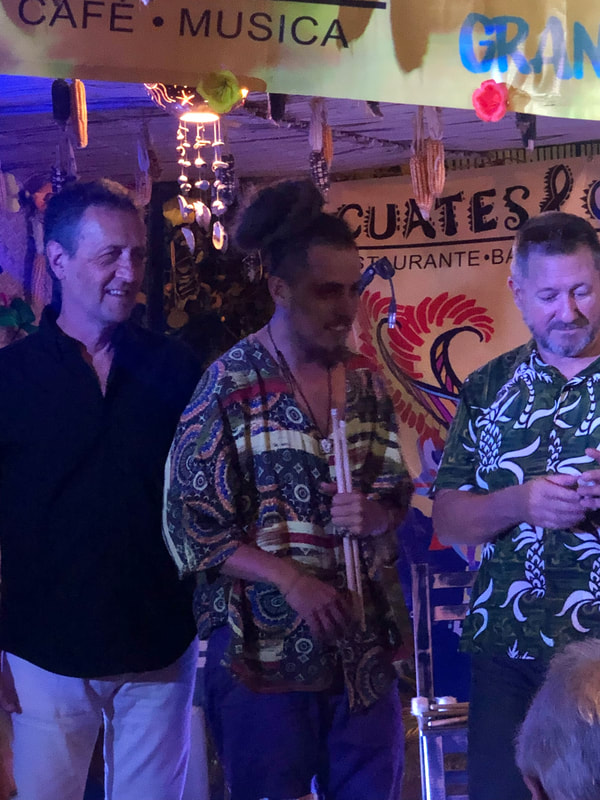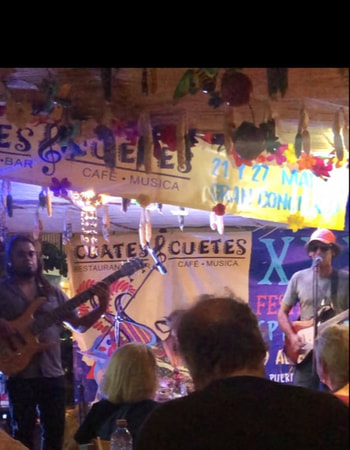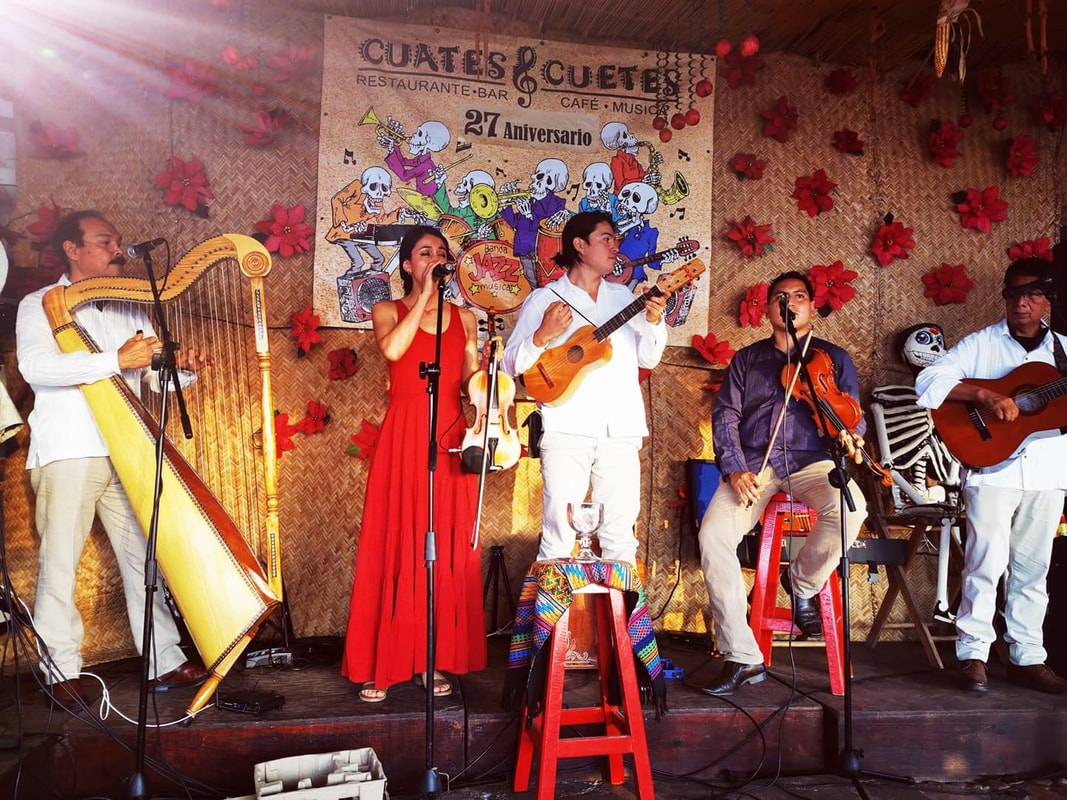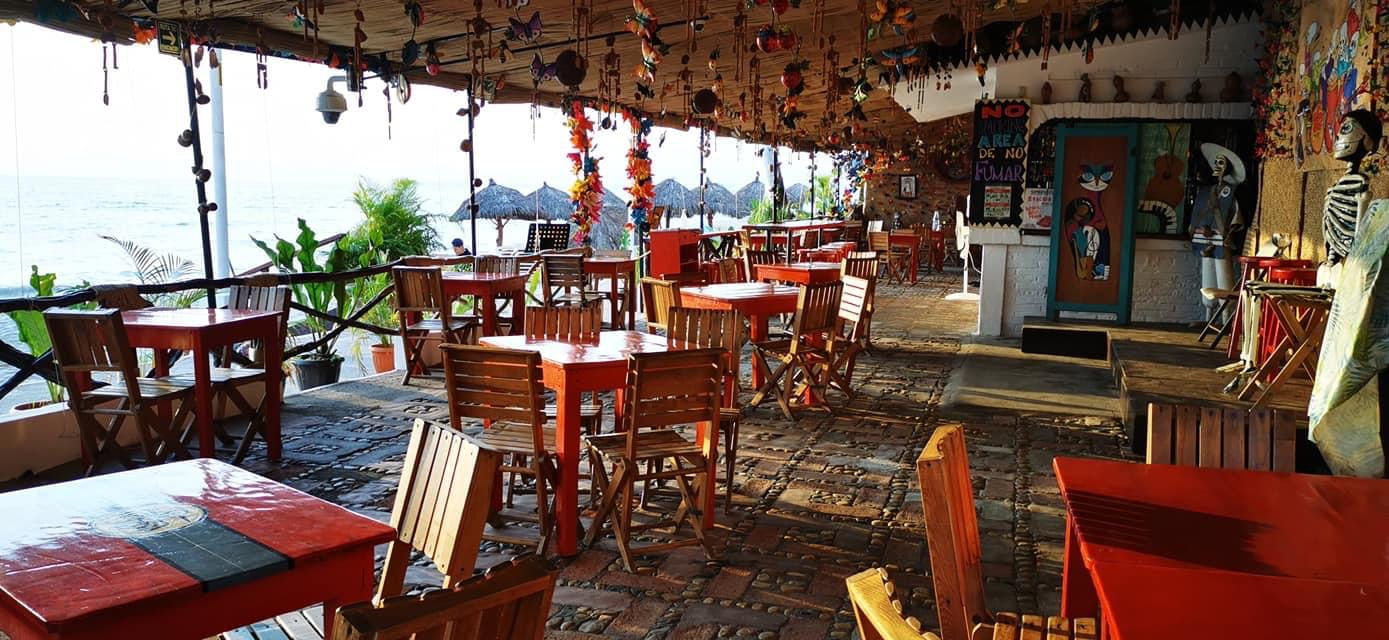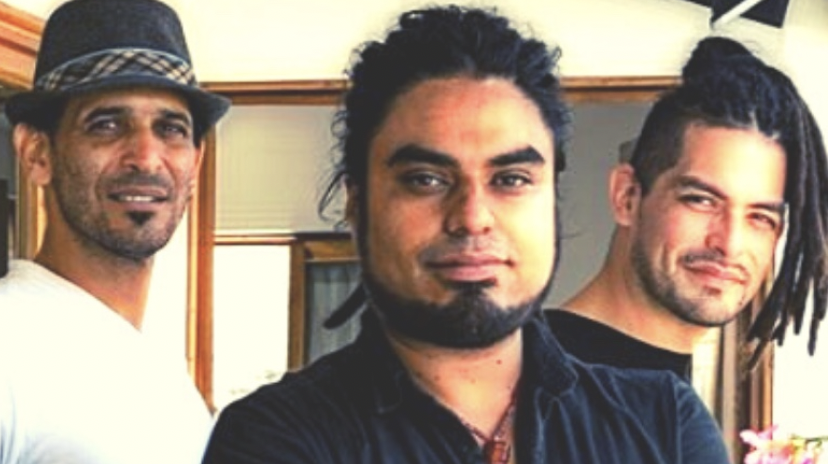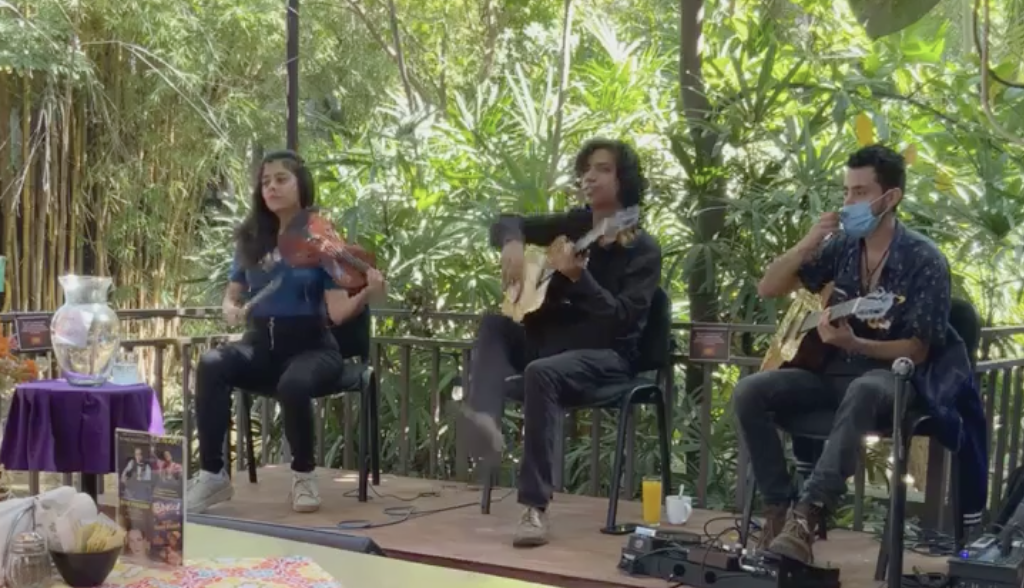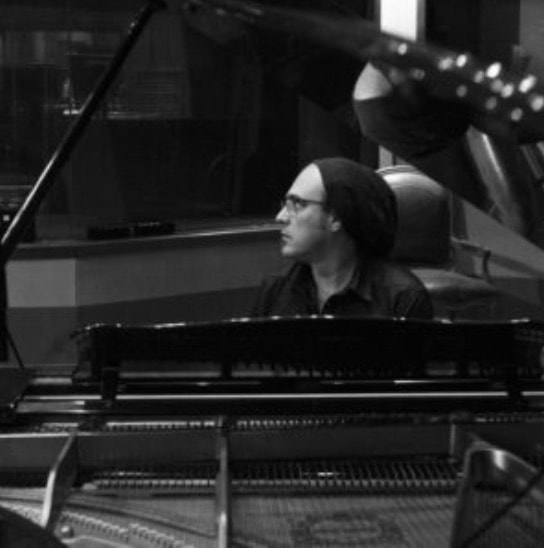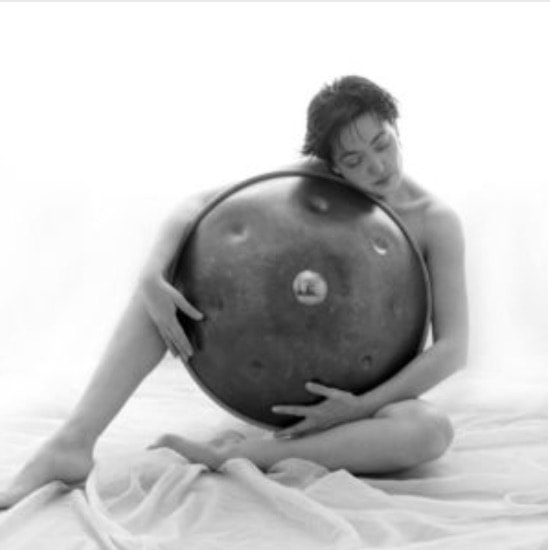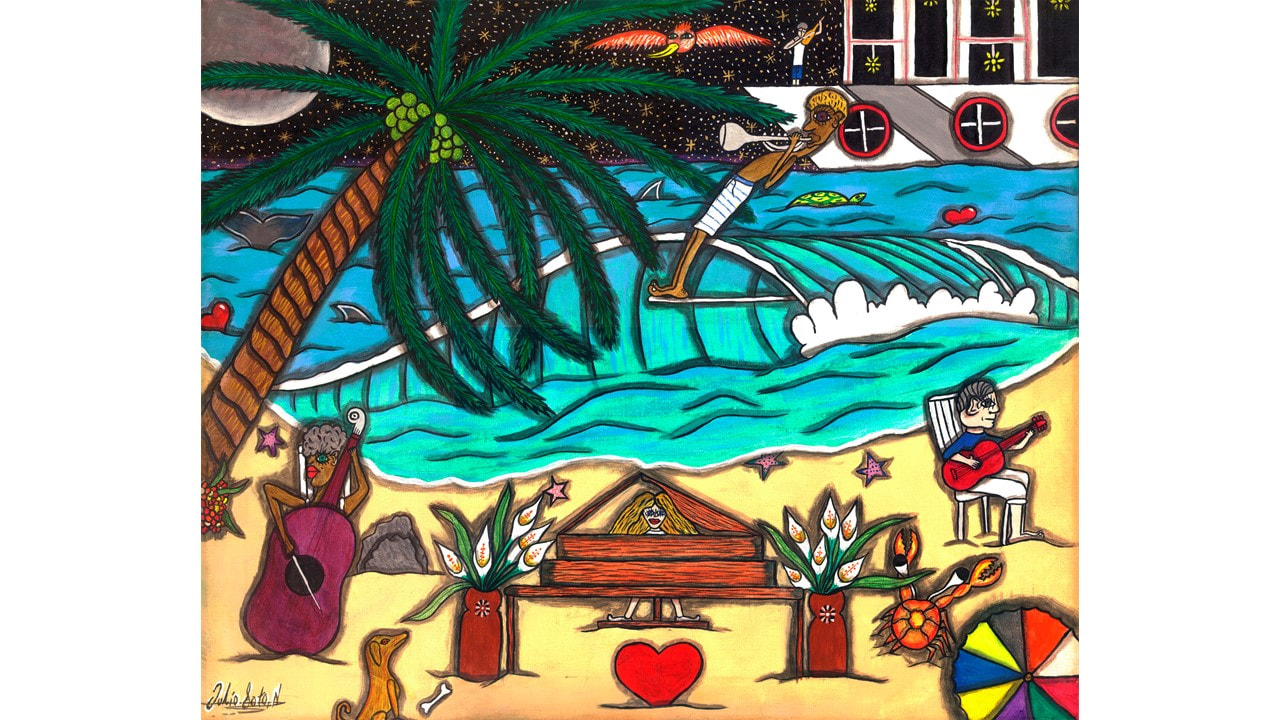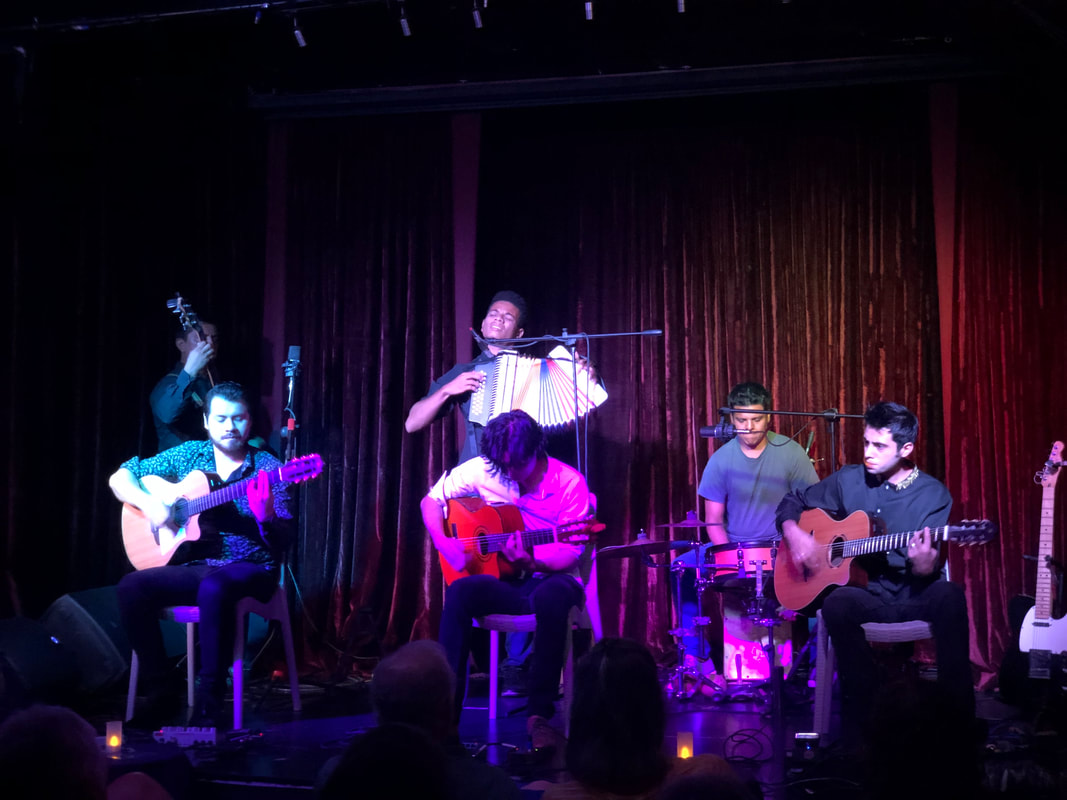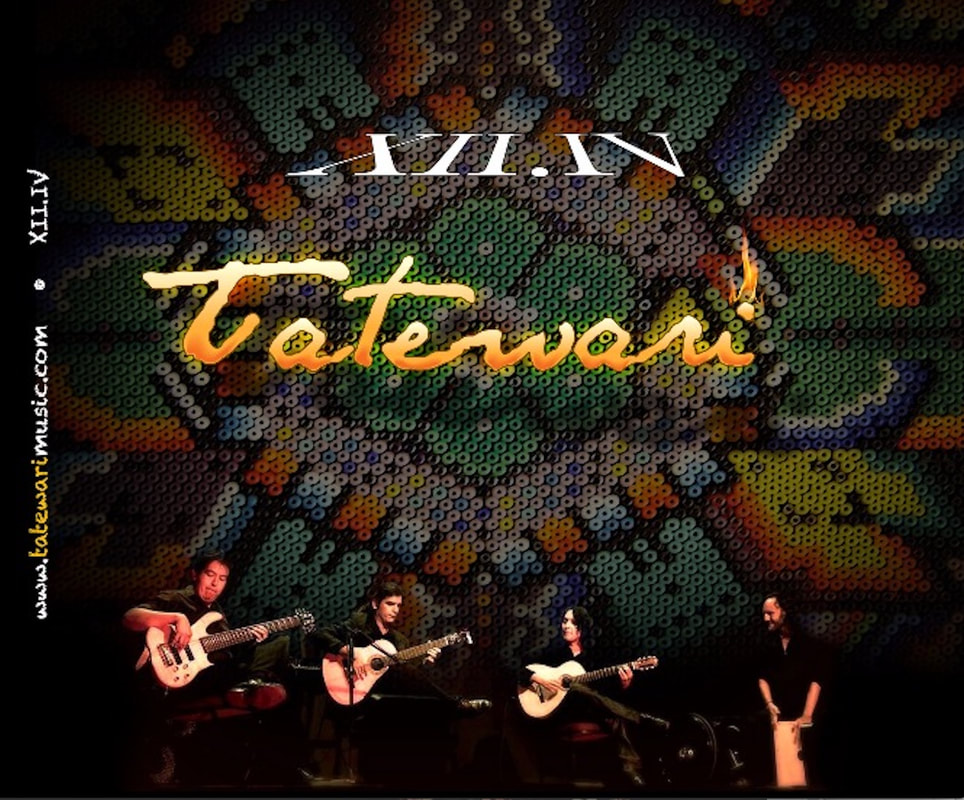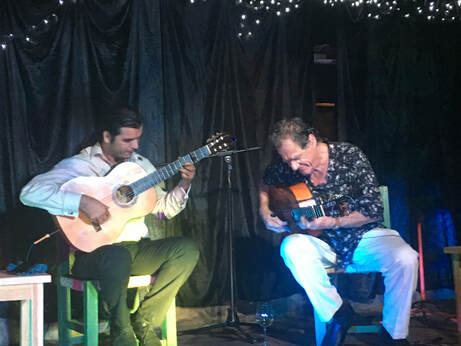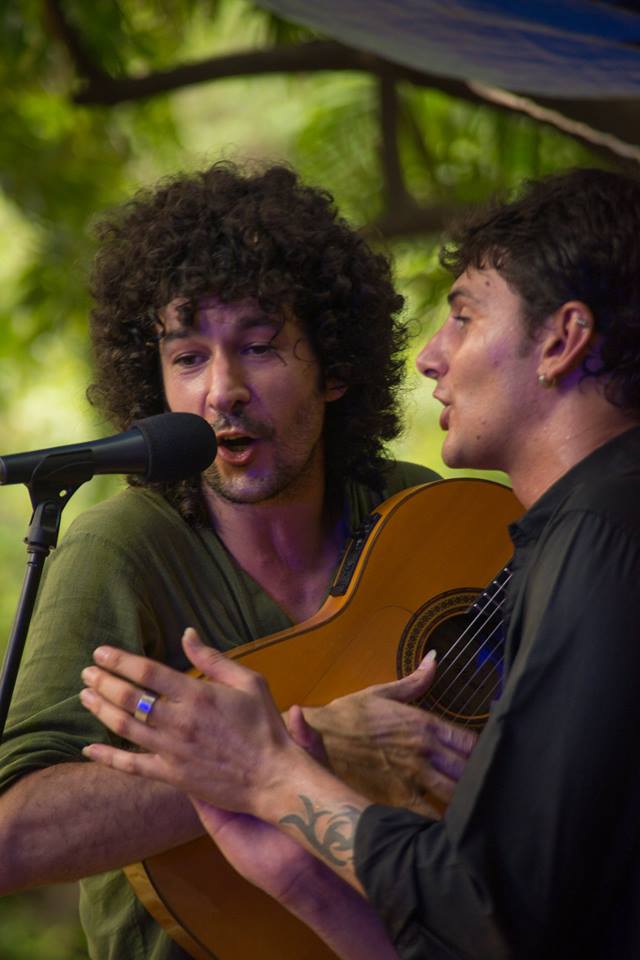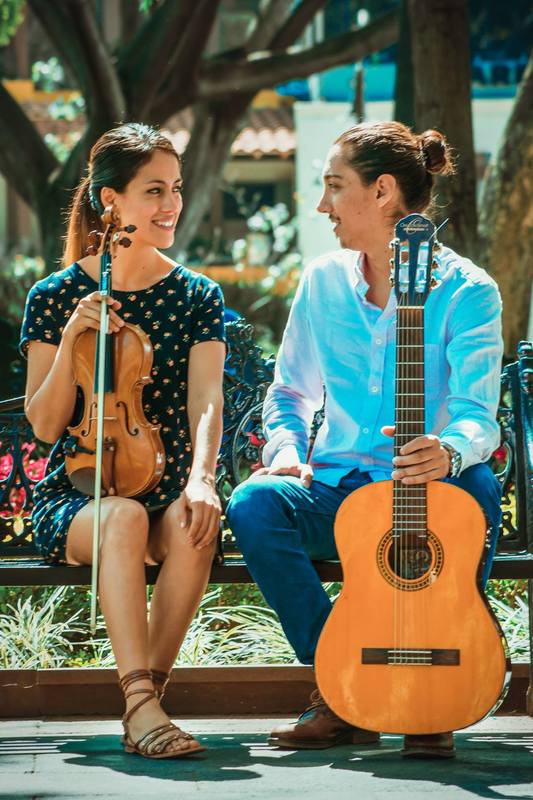Welcoming Spring with Music
Last Saturday kicked off the 26th Annual Jazz Festival and Celebration of Spring at Cuates y Cuetes Beachside Restaurant and Bar in front of the pier in the Zona Romantica. The celebration goes on until Sunday the 27 of March, and as always, it's a free event.
Every year at this time, hundreds of people from Puerto Vallarta and visitors to the area gather to immerse themselves in some of the best music Puerto Vallarta has to offer, including guests from around Mexico and abroad, friends from over the years of owner and organizer of the event, Doña Teté. Every year she invites us to celebrate with them the anniversary of the opening of the restaurant and jazz venue. Enchanted by jazz as a young woman, she has devoted her efforts to promoting the music here in Puerto Vallarta and has, in the process, introduced us to many extraordinary young talents as the years went by. This year is no exception, with around 20 different groups playing over the nine days.
Saturday night, the opening act was the Sam Dávalos Trio made up of Sam on fiery percussion, Torben Pederson from Canada giving an excellent performance on piano and Damien Aiken just in from Australia playing an inspired saxophone. They warmed the large crowd with various hot pieces—a perfect beginning.
Brazilian Brian Macedo's outstanding group Trem de Minas followed with incredible interaction between Brian on guitar and voice, Roberto Falcon on bass and San Dávalos standing in for Gary Flores, who could not attend. The exciting and original work of the group was outstanding and thrilled the fortunate listeners. The evening was a total success, with attendees promising to be back for the following day's performances.
Doña Teté was thrilled with the crowd's reception. She told us of the exciting new bands she has on the schedule for the rest of the week, including many new faces and combinations, sure to make for a special nine days of music and camaraderie. Teté reminded us, "we were not just a group of people from many different countries but a group of human beings united by music." Judging by Saturday night's program, this might be the most exciting festival yet.
Last Saturday kicked off the 26th Annual Jazz Festival and Celebration of Spring at Cuates y Cuetes Beachside Restaurant and Bar in front of the pier in the Zona Romantica. The celebration goes on until Sunday the 27 of March, and as always, it's a free event.
Every year at this time, hundreds of people from Puerto Vallarta and visitors to the area gather to immerse themselves in some of the best music Puerto Vallarta has to offer, including guests from around Mexico and abroad, friends from over the years of owner and organizer of the event, Doña Teté. Every year she invites us to celebrate with them the anniversary of the opening of the restaurant and jazz venue. Enchanted by jazz as a young woman, she has devoted her efforts to promoting the music here in Puerto Vallarta and has, in the process, introduced us to many extraordinary young talents as the years went by. This year is no exception, with around 20 different groups playing over the nine days.
Saturday night, the opening act was the Sam Dávalos Trio made up of Sam on fiery percussion, Torben Pederson from Canada giving an excellent performance on piano and Damien Aiken just in from Australia playing an inspired saxophone. They warmed the large crowd with various hot pieces—a perfect beginning.
Brazilian Brian Macedo's outstanding group Trem de Minas followed with incredible interaction between Brian on guitar and voice, Roberto Falcon on bass and San Dávalos standing in for Gary Flores, who could not attend. The exciting and original work of the group was outstanding and thrilled the fortunate listeners. The evening was a total success, with attendees promising to be back for the following day's performances.
Doña Teté was thrilled with the crowd's reception. She told us of the exciting new bands she has on the schedule for the rest of the week, including many new faces and combinations, sure to make for a special nine days of music and camaraderie. Teté reminded us, "we were not just a group of people from many different countries but a group of human beings united by music." Judging by Saturday night's program, this might be the most exciting festival yet.
Welcome back ex-pats!
With all the challenges of 2021, Puerto Vallarta is again showing its colors. Our part-time residents from up north are starting to trickle in, and the beaches, streets, restaurants and clubs are beginning to fill up. We expect it will be January before many of the restaurants and clubs affected by the pandemic and hurricane Nora will be back to normal but in the meantime, let's get out and enjoy all this paradise offers us.
As you know, my passion is music, especially that created by our local musicians. On my website vallartasounds.com you can read about many of these artists. You will find some changes as conditions have not allowed many large groups to continue playing together due to a lack of venues offering an opportunity for more than one or two players at a time. But their talent is such that they have created solo acts, regrouped, and are offering even more innovative and inspiring music.
Doña Teté of Cuates y Cuetes has done her best to see that we do not go without the jazz for which her place is famous. She offers music nightly from the open-air restaurant/bar in front of the pier in the Zona Romantica from 6:00 to 10:00 PM. They don't usually publish a schedule, but I will keep you informed as I learn who will be playing.
On Monday and Tuesday evenings, you can enjoy the terrific Latin fusion band, Media Luna, from 8:30-10:00. Guitarists Caleb and Jair Cabrera are joined this year by Mariel Ramos on the violin to make for a new dimension to their already incredible music. Showtime is 7:00 PM for music fans in La Cruz de Huanacaxtle, where they can catch Media Luna at the famous venue Tree House Bar on Coral Street on Wednesdays.
Nacho Flores (formerly Moruno) entertains us with his Mediterranean sounds on Thursday and Saturday evenings from 6:00 to 8:00 at Cuates y Cuetes, either solo or with the remarkable Jaime Ramon on percussion.
All-time favorites Beverly and Willow bring us cool jazz reminiscent of Ella Fitzgerald and are joined by Alexander Martinez Gil with his excellent guitar work in the style of Django Reinhardt on Wednesday and Thursdays evenings from 8:30 to 10:00.
River Cafe on the Rio Cuale Island has its music back! Troubadour/singer/songwriter Raul Simental performs with the excellent saxophone of Oscar Terrazas on Wednesday evenings, with Gaspar on percussion on Thursday, and on Fridays is jointed by the legendary Bob Tansen on flute. The music begins at 7:30, just on time for a cocktail or a nice meal by the river.
The fun begins at 11:00 PM at Ambar below the Jazz Foundation on the Malecon for night owls with renowned bassist Roberto Falcon and many guests on Wednesday nights! You will enjoy hearing from the new generation of musicians as well as your long-time favorites jamming on stage together. I think it is inspiring!
Several excellent restaurants in the bustling Versailles district feature Nacho Flores. He plays the relatively new pizza and beer garden, Fiamma, on Tuesday evenings from 7:30 to 9:30 and the already popular Italian restaurant, La Tosca Monday, Fridays, and Saturdays from 8 to 10. Great excuse to try out some new places for a beautiful dinner.
Try Garbos Piano Bar, where the Gipsy Rumba group Piel Canela plays on Saturday nights starting at 10:30 PM for a late cocktail date. Fernando Gonzales, Eduardo Leon, Pepe Galvan and Luis Rascon are all incredible musicians and together will have the place hopping. They can also be enjoyed at Nacho Daddy's on Tuesday evenings at 9:00.
I have happened down to El Dorado on the beach for a cocktail several nights and enjoyed lovely guitar/vocals and percussion while admiring the nighttime beach scene. Next door at La Palapa, Memo Suarez holds forth on drums with artists of his choice.
Please stay with me for future updates as I learn more about where our favorite artists will be playing. There is nothing better than music and the sound of the sea for lifting the spirits.
With all the challenges of 2021, Puerto Vallarta is again showing its colors. Our part-time residents from up north are starting to trickle in, and the beaches, streets, restaurants and clubs are beginning to fill up. We expect it will be January before many of the restaurants and clubs affected by the pandemic and hurricane Nora will be back to normal but in the meantime, let's get out and enjoy all this paradise offers us.
As you know, my passion is music, especially that created by our local musicians. On my website vallartasounds.com you can read about many of these artists. You will find some changes as conditions have not allowed many large groups to continue playing together due to a lack of venues offering an opportunity for more than one or two players at a time. But their talent is such that they have created solo acts, regrouped, and are offering even more innovative and inspiring music.
Doña Teté of Cuates y Cuetes has done her best to see that we do not go without the jazz for which her place is famous. She offers music nightly from the open-air restaurant/bar in front of the pier in the Zona Romantica from 6:00 to 10:00 PM. They don't usually publish a schedule, but I will keep you informed as I learn who will be playing.
On Monday and Tuesday evenings, you can enjoy the terrific Latin fusion band, Media Luna, from 8:30-10:00. Guitarists Caleb and Jair Cabrera are joined this year by Mariel Ramos on the violin to make for a new dimension to their already incredible music. Showtime is 7:00 PM for music fans in La Cruz de Huanacaxtle, where they can catch Media Luna at the famous venue Tree House Bar on Coral Street on Wednesdays.
Nacho Flores (formerly Moruno) entertains us with his Mediterranean sounds on Thursday and Saturday evenings from 6:00 to 8:00 at Cuates y Cuetes, either solo or with the remarkable Jaime Ramon on percussion.
All-time favorites Beverly and Willow bring us cool jazz reminiscent of Ella Fitzgerald and are joined by Alexander Martinez Gil with his excellent guitar work in the style of Django Reinhardt on Wednesday and Thursdays evenings from 8:30 to 10:00.
River Cafe on the Rio Cuale Island has its music back! Troubadour/singer/songwriter Raul Simental performs with the excellent saxophone of Oscar Terrazas on Wednesday evenings, with Gaspar on percussion on Thursday, and on Fridays is jointed by the legendary Bob Tansen on flute. The music begins at 7:30, just on time for a cocktail or a nice meal by the river.
The fun begins at 11:00 PM at Ambar below the Jazz Foundation on the Malecon for night owls with renowned bassist Roberto Falcon and many guests on Wednesday nights! You will enjoy hearing from the new generation of musicians as well as your long-time favorites jamming on stage together. I think it is inspiring!
Several excellent restaurants in the bustling Versailles district feature Nacho Flores. He plays the relatively new pizza and beer garden, Fiamma, on Tuesday evenings from 7:30 to 9:30 and the already popular Italian restaurant, La Tosca Monday, Fridays, and Saturdays from 8 to 10. Great excuse to try out some new places for a beautiful dinner.
Try Garbos Piano Bar, where the Gipsy Rumba group Piel Canela plays on Saturday nights starting at 10:30 PM for a late cocktail date. Fernando Gonzales, Eduardo Leon, Pepe Galvan and Luis Rascon are all incredible musicians and together will have the place hopping. They can also be enjoyed at Nacho Daddy's on Tuesday evenings at 9:00.
I have happened down to El Dorado on the beach for a cocktail several nights and enjoyed lovely guitar/vocals and percussion while admiring the nighttime beach scene. Next door at La Palapa, Memo Suarez holds forth on drums with artists of his choice.
Please stay with me for future updates as I learn more about where our favorite artists will be playing. There is nothing better than music and the sound of the sea for lifting the spirits.
2021! Fingers Crossed for a More Prosperous Year!
Hi everyone. 2020 was a crazy year in Puerto Vallarta as it was in the rest of the world. The pandemic has caused our musicians and venues, along with the rest of the population, of course, to suffer.
As opportunities to play music have been sporadic, everyone has been inventive to keep afloat to the best of their ability. Many musicians have done virtual performances with some success. I imagine at least they can put some frijoles on the table from time to time.
We're just getting to a point where things are starting to open up a bit in Puerto Vallarta. The governor has lifted some restraints as far as entertainment is concerned. Venues are opening, and people being allowed to be out on the street for more extended hours as long as they wear masks and maintain social distancing. Recently restaurants were allowed to have musical performances if they held to no more than a 50% occupancy, which has helped some of the bands. Most of them have been pruning their sizes down for these shows because it is challenging to support a five-member band, for example, when you only have an audience that will pay for only one or two people.
But we're getting by! I expect that March and April will open up even further as the clubs are now starting to open and lifting more severe restrictions. Some of the larger clubs arranged their areas to be more COVID safe and open, and those bands they engaged in doing full concerts. People are still cautious, I believe, and looking for places where they can be pretty safe regardless of what the restrictions say they can do.
I currently publish articles in the Puerto Vallarta Mirror and an online paper called vallartadaily.com (PVDN). I profile some of my favorite artists and tell readers where they are playing. If you happen to be in town, you can hear them in these comfortable and well-ventilated areas.
You can find some of these portraits here: https://www.vallartadaily.com/?s=christie+seeley
You can also consult vallartasounds.com Calendar page to see who is playing where! It is constantly updating! I hope we will all be together again soon in Puerto Vallarta listening to supurb music by our favorites!
Saludos y Abrazos!
As opportunities to play music have been sporadic, everyone has been inventive to keep afloat to the best of their ability. Many musicians have done virtual performances with some success. I imagine at least they can put some frijoles on the table from time to time.
We're just getting to a point where things are starting to open up a bit in Puerto Vallarta. The governor has lifted some restraints as far as entertainment is concerned. Venues are opening, and people being allowed to be out on the street for more extended hours as long as they wear masks and maintain social distancing. Recently restaurants were allowed to have musical performances if they held to no more than a 50% occupancy, which has helped some of the bands. Most of them have been pruning their sizes down for these shows because it is challenging to support a five-member band, for example, when you only have an audience that will pay for only one or two people.
But we're getting by! I expect that March and April will open up even further as the clubs are now starting to open and lifting more severe restrictions. Some of the larger clubs arranged their areas to be more COVID safe and open, and those bands they engaged in doing full concerts. People are still cautious, I believe, and looking for places where they can be pretty safe regardless of what the restrictions say they can do.
I currently publish articles in the Puerto Vallarta Mirror and an online paper called vallartadaily.com (PVDN). I profile some of my favorite artists and tell readers where they are playing. If you happen to be in town, you can hear them in these comfortable and well-ventilated areas.
You can find some of these portraits here: https://www.vallartadaily.com/?s=christie+seeley
You can also consult vallartasounds.com Calendar page to see who is playing where! It is constantly updating! I hope we will all be together again soon in Puerto Vallarta listening to supurb music by our favorites!
Saludos y Abrazos!
Bahia World Music Festival 2019–Coming December 7 & 8.
Jaír Cabrera, the co-founder of the popular Media Luna band, is the man behind the organization of Bahia World Music Festival. His dream is to create a yearly venue to showcase the incredible talent found around Banderas Bay and other parts of Mexico and bring this talent to the attention of an ever-broader audience, making the area a must on music-loving travelers' itineraries.
Aside from offering music by super talented musical groups, one of Jair's favorite features of the festival is a competition designed to motivate aspiring young people to realize their potential to become the future generation of musicians in our community and beyond. Contestants need only be under 18 years of age and play any instrument. The inscription is simple, as outlined on the festival website. There are cash prizes too! Finalists will perform at the festival, and members of the musical community will decide on the winners.
To anyone who follows my articles, it will come as no surprise that I am looking forward to two days of music played by some of my favorite local musicians. Since I first heard each of these groups, I have been amazed at their talents and ever-increasing creativity. Each of them brings its element to the program from the Flamenco music of Tatewari, the Mediterranean and jazz manouche of Moruno, the incredible Gypsy rumba and Latin fusion of Media Luna to the Brazilian jazz of Trem de Minas.
I am also very excited to see and hear the groups that will be visiting us from other parts of Mexico. It is a real privilege to have Pedro Dabdoub with us for this, our first, Bahia World Music Festival. Among his many achievements, he put together several collections of music for a record label, which was mostly responsible for my exposure to World Music, Putumayo.
Pedro Dabdoub was born in Mexico City in 1970 and moved to France at an early age, where he received an extensive education in classical music, mastering a variety of instruments. Returning to Mexico after his years in Paris and later Argentina, Pedro turned to more popular music, jazz, new age, and other creative forms.
He composed music for film and telenovelas. Famous performers like Alejandro Fernandez recorded his music. He produced and compiled new age and folk music for record labels like Putumayo. He is a recipient of numerous awards and celebrated for his contributions to education and many creative projects.
His latest project, Jazzpango, is described as stemming "from different musical streams that are characterized by improvisation – such as jazz, rock, rumba flamenco and huapango" and creating a "surprising, exciting and hypnotic language and environment." Jazzpango is the group he brings to our festival in its inaugural year.
YaYa Fuentes holds a particular interest for me because of my Peace Corps experience in her native country, Chile, and exposure to the music that came out of the tumultuous period from which she and her family fled. Add to that her mastery of the very rare musical instrument, the hang drum, which in addition to being so singular, she learned to play in Switzerland while living with the family who created it. It will be thrilling to watch her as she gracefully extracts magnificent sounds from this extraordinary musical instrument.
I adore the carefree style of the group Caravane and look forward to the vibrant beat of Rabeat, who will have us all on an imaginary dance floor throughout their performance.
The elegant setting of Oscar's Tequila Distillery, where the festival will take place, is the icing on the cake. With the River Cuale on both sides and the lovely Banderas Bay in front, it is doubtful a more delightful setting could be found to spend two days listening to the awe-inspiring sounds produced by these talented musicians. The festival will take place from 5:00 PM to midnight on both Saturday and Sunday.
For more information and tickets visit the festival website worldmusicfestival.mx
Tickets also available at Oscar's Restaurant and Babel Bar, both on River Cuale Island
Aside from offering music by super talented musical groups, one of Jair's favorite features of the festival is a competition designed to motivate aspiring young people to realize their potential to become the future generation of musicians in our community and beyond. Contestants need only be under 18 years of age and play any instrument. The inscription is simple, as outlined on the festival website. There are cash prizes too! Finalists will perform at the festival, and members of the musical community will decide on the winners.
To anyone who follows my articles, it will come as no surprise that I am looking forward to two days of music played by some of my favorite local musicians. Since I first heard each of these groups, I have been amazed at their talents and ever-increasing creativity. Each of them brings its element to the program from the Flamenco music of Tatewari, the Mediterranean and jazz manouche of Moruno, the incredible Gypsy rumba and Latin fusion of Media Luna to the Brazilian jazz of Trem de Minas.
I am also very excited to see and hear the groups that will be visiting us from other parts of Mexico. It is a real privilege to have Pedro Dabdoub with us for this, our first, Bahia World Music Festival. Among his many achievements, he put together several collections of music for a record label, which was mostly responsible for my exposure to World Music, Putumayo.
Pedro Dabdoub was born in Mexico City in 1970 and moved to France at an early age, where he received an extensive education in classical music, mastering a variety of instruments. Returning to Mexico after his years in Paris and later Argentina, Pedro turned to more popular music, jazz, new age, and other creative forms.
He composed music for film and telenovelas. Famous performers like Alejandro Fernandez recorded his music. He produced and compiled new age and folk music for record labels like Putumayo. He is a recipient of numerous awards and celebrated for his contributions to education and many creative projects.
His latest project, Jazzpango, is described as stemming "from different musical streams that are characterized by improvisation – such as jazz, rock, rumba flamenco and huapango" and creating a "surprising, exciting and hypnotic language and environment." Jazzpango is the group he brings to our festival in its inaugural year.
YaYa Fuentes holds a particular interest for me because of my Peace Corps experience in her native country, Chile, and exposure to the music that came out of the tumultuous period from which she and her family fled. Add to that her mastery of the very rare musical instrument, the hang drum, which in addition to being so singular, she learned to play in Switzerland while living with the family who created it. It will be thrilling to watch her as she gracefully extracts magnificent sounds from this extraordinary musical instrument.
I adore the carefree style of the group Caravane and look forward to the vibrant beat of Rabeat, who will have us all on an imaginary dance floor throughout their performance.
The elegant setting of Oscar's Tequila Distillery, where the festival will take place, is the icing on the cake. With the River Cuale on both sides and the lovely Banderas Bay in front, it is doubtful a more delightful setting could be found to spend two days listening to the awe-inspiring sounds produced by these talented musicians. The festival will take place from 5:00 PM to midnight on both Saturday and Sunday.
For more information and tickets visit the festival website worldmusicfestival.mx
Tickets also available at Oscar's Restaurant and Babel Bar, both on River Cuale Island
Fall and Winter in Puerto Vallarta with Bahia World Music Festival
Bahia World Music Festival is bringing a great selection of music representing traditions from around the world to Puerto Vallarta on December 7 and 8, 2019. The festival will be held on the luxurious grounds of Oscar's Tequila Distillery on the Island at the mouth of the River Cuale. Sponsored by Vallartasounds.com and Jair Cabrera, co-founder of the exciting gypsy rumba band Media Luna, this festival promises to be exceptional. Featuring the some of the best bands in Puerto Vallarta along with original and unique groups from around Mexico. The event website is worldmusicfestival.mx. There you will find information about the bands, venue and can even purchase your tickets from there on eventbrite. More to come!
To view my most recent articles in the Vallarta Tribune about the goings on in Puerto Vallarta Music and more, go to: vallartatribune.com/author/christie-seeley/
To view my most recent articles in the Vallarta Tribune about the goings on in Puerto Vallarta Music and more, go to: vallartatribune.com/author/christie-seeley/
Winter and Spring 2019--Media Luna, San Pancho Festival, Tatewari and Lobo and Esau in Concerts
The sky is the limit for the young artists of Media Luna this year. In addition to their extremely popular weekly show at Incanto Cabaret Theater here in Puerto Vallarta every Thursday evening at 7:00, they will be playing high in the mountains at San Sebastian del Oeste on February 23-24 at an overnight annual event held at an historic hacienda. More information on this event is on my website www.vallartasounds.com and their face book page. From there they will go on to San Miguel de Allende for a number of engagements. Lucky for us, they will return to Incanto for their Thursday shows each week so be sure you get your tickets early and don’t miss out.
The talented young men of Media Luna are scheduled to play at Bellas Artes in San Miguel de Allende on the 15th of March! This incredible band so popular here in Puerto Vallarta is also in huge demand in San Miguel. If you are traveling to the Bajío or have friends there, you will want the details which you can find in the Media Luna section of this website.
Coming up next week is a great annual event that, I understand, got its start in the private home of music aficionados years ago in the town of San Francisco (San Pancho), Nayarit, just north of Puerto Vallarta, and grew to the wonderful festival that it is today after 19 years. At this joyful celebration local and imported musicians as well as organizers donate their time to provide entertainment to the multitude of people who gather at the Plaza del Sol in San Pancho every year to celebrate the tradition of music in the area. The list of entertainers is not published until the beginning of the festivities on the festival’s website but I know my good friends of Tatewari will be playing their fiery flamenco music on the final day, Sunday, February 24 at 8:45 followed by Lobo (Wolfgang Fink) and Esaú Galván playing masterful free flowing improvised flamenco guitar.
The music begins daily on the 22, 23 and 24th of February at 5:00PM and lasts until 11:00PM. Some chairs are provided but organizers recommend you bring your own if you want to be guaranteed a seat. There will be food and refreshment stands (both alcoholic and non-alcoholic) and also CDs and other offerings for sale. The event is free to all comers so don’t miss out! San Pancho is also a lovely place to visit.
There is lots of good music on the horizon for March. Lobo and Esaú will return to Incanto for an encore of their Sold Out January show on March 2. Their first show was extremely popular so now is the time to make plans for this one as tickets will go fast. It will be held in Incanto’s beautiful cabaret theater located at Insurgentes 109, next to the bridge crossing the River Cuale in Puerto Vallarta. The show will begin at 7:00PM and you can purchase tickets at incantovallarta.com or at the box office.
If you don’t know already, Lobo an already celebrated flamenco guitarist from Bavaria and Esaú met many years ago when Esaú, just a boy at the time, sought his advice on some tricky guitar issues and Lobo helped him out, really jump starting Esau’s career encouraging him to study flamenco guitar. He is now a considerable guitarist and the two remain good friends, performing beautifully together to the delight of their audiences. This will be a spectacular opportunity to hear these two maestros charm with their innovative and often surprising music. The two will then go on to perform in La Cruz de Huanacaxtle on March 3. (Tree House Bar, Coral 66, 7:00 PM) See venues on this website for details on Tree House Bar.
The group Tatewari formed twelve years ago by Esaú and his childhood friends from La Cruz de Huanacaxtle Dani Márquez (bass) and Alberto Ramirez (guitar) and completed later on with the addition of Canadian Sonny Davis on Cajón, will have the last of their extremely popular La Cruz concerts for the season on March 11 at 7:00. Word has it that they will also have some marvelous concerts at Incanto in April so stay tuned from more on that. Their very popular 4th CD is out and just full of beautiful original pieces!
Tatewari will also be featured at a dinner/show at Babel Bar on the evening of March 9.
The talented young men of Media Luna are scheduled to play at Bellas Artes in San Miguel de Allende on the 15th of March! This incredible band so popular here in Puerto Vallarta is also in huge demand in San Miguel. If you are traveling to the Bajío or have friends there, you will want the details which you can find in the Media Luna section of this website.
Coming up next week is a great annual event that, I understand, got its start in the private home of music aficionados years ago in the town of San Francisco (San Pancho), Nayarit, just north of Puerto Vallarta, and grew to the wonderful festival that it is today after 19 years. At this joyful celebration local and imported musicians as well as organizers donate their time to provide entertainment to the multitude of people who gather at the Plaza del Sol in San Pancho every year to celebrate the tradition of music in the area. The list of entertainers is not published until the beginning of the festivities on the festival’s website but I know my good friends of Tatewari will be playing their fiery flamenco music on the final day, Sunday, February 24 at 8:45 followed by Lobo (Wolfgang Fink) and Esaú Galván playing masterful free flowing improvised flamenco guitar.
The music begins daily on the 22, 23 and 24th of February at 5:00PM and lasts until 11:00PM. Some chairs are provided but organizers recommend you bring your own if you want to be guaranteed a seat. There will be food and refreshment stands (both alcoholic and non-alcoholic) and also CDs and other offerings for sale. The event is free to all comers so don’t miss out! San Pancho is also a lovely place to visit.
There is lots of good music on the horizon for March. Lobo and Esaú will return to Incanto for an encore of their Sold Out January show on March 2. Their first show was extremely popular so now is the time to make plans for this one as tickets will go fast. It will be held in Incanto’s beautiful cabaret theater located at Insurgentes 109, next to the bridge crossing the River Cuale in Puerto Vallarta. The show will begin at 7:00PM and you can purchase tickets at incantovallarta.com or at the box office.
If you don’t know already, Lobo an already celebrated flamenco guitarist from Bavaria and Esaú met many years ago when Esaú, just a boy at the time, sought his advice on some tricky guitar issues and Lobo helped him out, really jump starting Esau’s career encouraging him to study flamenco guitar. He is now a considerable guitarist and the two remain good friends, performing beautifully together to the delight of their audiences. This will be a spectacular opportunity to hear these two maestros charm with their innovative and often surprising music. The two will then go on to perform in La Cruz de Huanacaxtle on March 3. (Tree House Bar, Coral 66, 7:00 PM) See venues on this website for details on Tree House Bar.
The group Tatewari formed twelve years ago by Esaú and his childhood friends from La Cruz de Huanacaxtle Dani Márquez (bass) and Alberto Ramirez (guitar) and completed later on with the addition of Canadian Sonny Davis on Cajón, will have the last of their extremely popular La Cruz concerts for the season on March 11 at 7:00. Word has it that they will also have some marvelous concerts at Incanto in April so stay tuned from more on that. Their very popular 4th CD is out and just full of beautiful original pieces!
Tatewari will also be featured at a dinner/show at Babel Bar on the evening of March 9.
September 2018--Fall and Winter Season in Puerto Vallarta
Summer season in Puerto Vallarta is wrapping up and venues are gearing up for the fall/winter season. Babel Bar on the Rio Cuale has presented some great music in its outdoor garden area next to the river for the last several months. Spanish guitarist Diego Mateo and Nacho Flores a maestro on many wonderful string instruments, both composing the talented group Moruno, along with Santiago Martin Spanish vocalist and guitarist and Dani Choy on percussion have brightened up many Saturday afternoons. Eduardo Leon and Zoe Wood have joined them with gypsy guitar, voice and original compositions. The weather seems to have held out for them and everyone has had a great time.
Just down the island at the Insurgentes bridge, the restaurant/bar/theater Incanto has offered a very nice summer program, just finishing up with Lady Zen, The Greater Tuna, Gypsy Rumba—great shows in the theater, and musical presentations by Zoe Wood, Eduardo Leon, Santiago Martin and his group, Red Suitcases, Joby Hernandez at Open Mic and of course Pearl’s Bingo afternoons and Denis Crow’s late night sing alongs in the Piano Bar continue. They have kept us all entertained and cool in the heat with their air conditioning and dry and out of the rain on stormy nights.
Cuates y Cuetes down by the pier in the Zona Romantica featured Moruno Sunday and Tuesday evenings and the sought after flamenco group Tatewari on Wednesday evenings all summer long along with daytime performances by Esaú Galván flamenco guitarist on Saturday at brunch time and Nacho Flores and Magali Uribe on Wednesday and Thursdays. Moruno also played on Fridays for lunch. All great talents and wonderful shows.
Our hardworking empresarios are busy now lining up the wonderful shows we will enjoy this winter. I know for certain we can expect some great entertainment from the fiery flamenco group Tatewari. Incanto will present the release of the groups new cd 12.4 (4th cd in 12 years playing together) in December with a wonderful show including new music (all original compositions), guest artists, flamenco dancer and accompaniments. In their home town of La Cruz de Huanacaxtle they also have 5 tremendous concerts lined up for the season.
Los Bambinos return to their restaurant/bar in October with great food and fun music that entertains loads of regular and new fans all season long.
The extremely popular guitar group Media Luna will be back from San Miguel de Allende at Incanto for the season starting in December! They have many new sounds in store for us as well as the pieces we loved last year. They are excited to return!
Cuates y Cuetes will fill out their calendar including our very favorites like Tatewari and Moruno and new groups as well. We will keep you informed.
River Cafe will continue to feature Raul Simental with Oscar Terrazas, Bob Tansen and other guests.
I personally am very much hoping to see Gato Negro, an incredible group from Leon, Guanajuato here in December. They are extremely talented and play an innovative jazz manouche (French gypsy inspired jazz) that will thrill us all. They keep very busy in Leon but Osmar Esquivel on violin, guitar and accordion, who you may remember from a few years ago with Moruno, misses Puerto Vallarta and would love to see his old friends again as well as introduce the group and the new music of their cd Ciudad de Arcilla including a beautiful piece, El Muelle, which he composed right next to the pier when he lived here. (See page for Gato Negro on this website.)
The fall/winter season begins in October and builds up as the months progress. October, November and December are great times to visit as the full onslaught of winter visitors has not yet arrived and one has cooler weather and a somewhat quieter period to enjoy the tranquil and yet exciting Banderas Bay area.
Just down the island at the Insurgentes bridge, the restaurant/bar/theater Incanto has offered a very nice summer program, just finishing up with Lady Zen, The Greater Tuna, Gypsy Rumba—great shows in the theater, and musical presentations by Zoe Wood, Eduardo Leon, Santiago Martin and his group, Red Suitcases, Joby Hernandez at Open Mic and of course Pearl’s Bingo afternoons and Denis Crow’s late night sing alongs in the Piano Bar continue. They have kept us all entertained and cool in the heat with their air conditioning and dry and out of the rain on stormy nights.
Cuates y Cuetes down by the pier in the Zona Romantica featured Moruno Sunday and Tuesday evenings and the sought after flamenco group Tatewari on Wednesday evenings all summer long along with daytime performances by Esaú Galván flamenco guitarist on Saturday at brunch time and Nacho Flores and Magali Uribe on Wednesday and Thursdays. Moruno also played on Fridays for lunch. All great talents and wonderful shows.
Our hardworking empresarios are busy now lining up the wonderful shows we will enjoy this winter. I know for certain we can expect some great entertainment from the fiery flamenco group Tatewari. Incanto will present the release of the groups new cd 12.4 (4th cd in 12 years playing together) in December with a wonderful show including new music (all original compositions), guest artists, flamenco dancer and accompaniments. In their home town of La Cruz de Huanacaxtle they also have 5 tremendous concerts lined up for the season.
Los Bambinos return to their restaurant/bar in October with great food and fun music that entertains loads of regular and new fans all season long.
The extremely popular guitar group Media Luna will be back from San Miguel de Allende at Incanto for the season starting in December! They have many new sounds in store for us as well as the pieces we loved last year. They are excited to return!
Cuates y Cuetes will fill out their calendar including our very favorites like Tatewari and Moruno and new groups as well. We will keep you informed.
River Cafe will continue to feature Raul Simental with Oscar Terrazas, Bob Tansen and other guests.
I personally am very much hoping to see Gato Negro, an incredible group from Leon, Guanajuato here in December. They are extremely talented and play an innovative jazz manouche (French gypsy inspired jazz) that will thrill us all. They keep very busy in Leon but Osmar Esquivel on violin, guitar and accordion, who you may remember from a few years ago with Moruno, misses Puerto Vallarta and would love to see his old friends again as well as introduce the group and the new music of their cd Ciudad de Arcilla including a beautiful piece, El Muelle, which he composed right next to the pier when he lived here. (See page for Gato Negro on this website.)
The fall/winter season begins in October and builds up as the months progress. October, November and December are great times to visit as the full onslaught of winter visitors has not yet arrived and one has cooler weather and a somewhat quieter period to enjoy the tranquil and yet exciting Banderas Bay area.
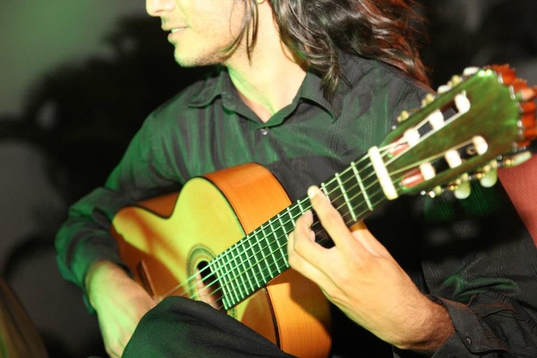
...Yo canto su elegancia con palabras que gimen y recuerdo una brisa triste por los olivos.
Federico Garcia Lorca
de Llanto por La Muerte de Ignacio Sánchez Mejía
Introducing a new website: www.esaugalvan.com
May 2018--Flamenco and Gypsy Guitar, an evolution
En Español En Français
Are you confused about the distinction between gypsy jazz and flamenco? Well you are not alone. With the proliferation of groups playing music defined as gypsy jazz, gypsy rumba, flamenco, which we love listening to, we may be scratching our heads wondering what the difference is if any. I recently read a very informative and well researched analysis of this question by Ronald Lee, a Canadian expert on the subject which I will try to paraphrase here. Lee is a Rumani translator, author and educator. (http://kopachi.com/?s=roma+flamenco).
My question was “what is the difference between Gypsy music and Flamenco. Mr. Lee, in his essay Roma and Flamenco, Myth and Reality, tells us that the myth that Flamenco derived directly from Roma music is somewhat misleading. First of all, during the Moorish rule of what is now Spain ending in 1492, Cordoba was an important center for music and the music from many areas of the Near East, Africa and India was brought to the area by music students from all over the world. This musical input was probably integrated into what was then the folk music of the area. The Roma people are not seen in Spain until the very end of the Moorish period at the earliest.
Over the years, the Romas had moved from India, through Eastern Europe and eventually into Spain. According to Lee, the instruments used during these periods as well as the rhythms were quite similar and the integration of influences gathered along the journey produced the music brought by the Roma people into Spain when they arrived in the late 15th century. They brought with them their music which merged into the local folk music at the time and became what is today known as Flamenco.
Early on Roma people lived freely in various parts of Spain but due to an edict by King Ferdinand V and Isabela I, requiring conversion to Christianity and cessation of nomadic practices which was eventually strongly enforced by Carlos I in 1593, those Romas who survived and remained were concentrated in gitanerías in Andalusia, specifically in the caves of Sacromonte. By the way, the term Flamenco seems to have derived from the fact that the many Romas participated in the wars against the Moors as well as the Flemish wars of that earlier period. Those who returned from the wars were sometimes referred to as Flamencos and the music took on the name. Lee asks the question if Flamenco music would have existed if the Romas had not come to Spain. His answer is that it would have been very different.
Lee describes the evolution of Flamenco as we know it today in its more sophisticated form.
“Like the blues in America or rembetiko music in Greece, it began as the esoteric music of the ghetto, slums or gitanerías, then travelled to the local honky-tonk frequented by its marginalized sub-culture of outcast creators, then to the cafés of the aficionados or fans who had suddenly discovered it, and finally to the concert stage. There it was stripped of its raw folk origin when adopted by the genteel sophisticates, stylised and made more acceptable to those who had never known the pain of rejection, jails, hunger and persecution.”
The Flamenco music that we hear in concert halls today often follows this pattern. However, many modern interpreters have travelled and studied with Gypsies in Spain, specifically Sacromonte, and with those in Southern France (think Gypsy Kings) and from this exposure comes a more authentic Flamenco puro.
Flamenco music often has a very melancholic, tragic feeling, somewhat like the Portuguese Fado. This was especially true in its early form when canto (voice) and then dance were placed higher in importance than the guitar which was considered an accompaniment. The 20th century brought the rise of the importance of the guitarist as virtuoso and popularity of the more spirited sound of Rumba, the music having traveled from Spain to Cuba and back resulting in a more festive rhythm. Django Reinhardt and others played a big role in popularizing the music in Europe, followed by the Gypsy Kings of the current period.
Hopefully some of this information helps to clarify our confusion regarding definitions. However, it is not necessary to understand all of the history to enjoy the marvelous sounds being produced right here in Vallarta following the Flamenco tradition. Happy listening!
